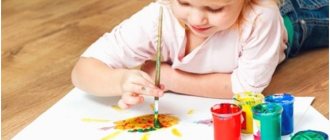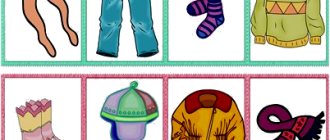All children one day begin to experience a craving for drawing. They enjoy experimenting with color and art materials. It is important to notice the moment when the baby himself begins to reach for pencils or felt-tip pens and carefully suggest how to use them correctly. Never force children to draw if they don't want to. Always try to create a relaxed creative atmosphere, give the kids freedom of expression. But at the same time, unobtrusively give advice on how to handle a brush, pencil, and paints.
The benefits of drawing for children
Why do all teachers and psychologists recommend starting drawing with children as early as possible? Teaching your child to draw is really important. Creativity is useful for children of early and preschool age for the following reasons:
- stimulates fine motor skills and logic,
- develops speech,
- helps formulate thoughts, suggestions,
- improves the function of self-expression,
- promotes self-affirmation,
- teaches you to make non-standard decisions,
- develops memory and attention,
- helps improve diligence and perseverance.
The process of drawing for children 2-3 years old and even younger will give a lot of joyful emotions and help diagnose various problems - medical, psychological. Drawing fights complexes, isolation, and self-doubt. This art also lays down the aesthetic perception of the world and reveals the creative inclinations of the child from an early age. Drawing with parents is a reason for additional time together and entertainment.
Age at which drawing began
The need to draw in a child may arise at a young age - at 1 year or a little later. Most children have a clearly visible craving for bright colors and a desire to depict something on paper by the age of 1.5-2 years. Of course, the first drawings are painted spots, but the child works more and more actively each time. Also, often his “talents” become noticeable on furniture, walls, wallpaper, but psychologists do not recommend strongly scolding a child for this, so as not to discourage the desire to create.
By about 4-5 years old, children can already begin to attend drawing lessons if they have the desire and inclination. You can learn to draw beautiful pictures at home, studying with your parents. There are now a lot of useful master classes and thematic information on the Internet. Children 7-8 years old and older can attend school drawing classes, where they will be taught about the basics of painting and taught many interesting things.
Skill Development
If a child has an increased interest in the drawing process, it makes sense to enroll him in a specialized school, kindergarten or children's creativity center, where he can gain additional skills in drawing techniques, develop aesthetic taste, accuracy and creative imagination under the guidance of a professional teacher. He will acquire the ability to see beauty and create it independently, depict his thoughts, and bring his plans to life.
If your child has lost interest in drawing, do not despair - this is not forever. Sometimes a child temporarily needs to switch to something else in order to return to drawing with pleasure.
Find out how to teach a child to draw from the video:
Read how to easily do face painting for the New Year and other holidays in our article.
What colors are suitable - choosing a material for children's creativity
For young children, it is recommended to choose finger paints that are ideal for painting with fingers and palms. They can also be used later using a brush.
Children from 4 years old can already purchase gouache for drawing. These paints are perfect for beginners. Their density allows you to consistently apply colored layers and paint over damaged fragments. Usually, for coloring or drawing pictures in an album, a set of 6 colors is enough, from which you can get many new shades. For older children, it is better to buy larger sets - 10 colors or more. From the age of 6 you can already switch to watercolor paints, and at the age of 7-9 you can use acrylic dyes for creativity (for example, for painting on foil, fabric).
Chaotic doodles
Up to a year old, the baby picks up a pencil and starts poking it at a piece of paper, rejoicing that it leaves marks. These are the first doodle drawings. At this moment, the child can look around, at his mother, and continue to poke. He makes chaotic scribbles.
The child makes an important discovery for himself: he can leave traces in this world!
If you give the child a piece of paper and a pencil during this period, he will draw the pencil over the piece of paper with interest, not respecting the boundaries. At this stage, his visual-motor coordination (eye-hand) has not yet been formed: the eyes do not follow what the hand is doing, but the hand acts as it turns out.
At this time, mom can give 1 piece of paper and 1 drawing tool: a soft pencil or felt-tip pen, finger paints, and if your child is still actively exploring the world through his mouth, then a natural dye, such as carrot or beet juice. It is enough to give just one copy, and not a scattering of pencils and markers and a whole album. This will help your child focus on leaving marks rather than trying to taste everything.
And it’s important that mom gives feedback: “Wow, how cool!”, “How many and beautiful things you drew!” - so that the baby gets the experience of a positive reaction to his actions. Especially for leaving traces.
Any smearing of anything during this period (often porridge on the table, vegetables, pasta) is part of the experience of leaving marks. Therefore, we carefully respond to such actions, without criticism or negative emotional reactions. We simply help the child finish his food and go do other things so that lunch or dinner does not turn into developmental activities.
So, at this stage the child gains the experience that leaving marks is a very, very good thing!
Chaotic scribbles are a fairly short period; children very soon move on to the next stage: circular scribbles.
Start drawing - selection of drawings
When drawing, you need to act in stages - move from easy to complex. Mom can give the baby “lessons” in drawing as soon as he is able to hold different objects with his hands. First, it is advisable to offer the child a pencil, after showing how to use it to make lines on paper. Having understood the meaning of the work, the child will treat it with interest.
From the age of 1.5 years, a child can already make the simplest drawings - dashes, similarities to figures. Gradually, tasks and goals become more complicated, but no strict demands are made on the child. On the contrary, it is desirable for him to go through the “staining phase”, which ends around the age of two. Further recommendations for creating drawings will be as follows:
- 2-3 years – initial skills in working with a brush, drawing flowers, geometric shapes, first snow, etc.,
- 4-5 years – painting, shading, working with pencils, brushes,
- 6-7 years and older - drawing compositions, landscape paintings, forests, animals, studying portrait techniques.
Using paints
A separate stage in learning to draw is working with watercolors and gouache.
We also recommend purchasing brushes made from soft pony or squirrel bristles, thick A3 or larger paper that can be mounted on the wall, a sippy cup and a palette for mixing paints.
Present these props to the child in the form of a beautiful story, and present the brushes and paints as characters in the performance. Use coloring lessons to introduce your child to primary colors. Practice combining them and selecting them for certain items.
Before starting to paint, make sure, as in the case of a pencil, that your child holds the brush correctly and controls his pressure on it. Pay attention to how to pick up paint, apply it to paper, and how to rinse and blot your brush. Start painting with one color, gradually increasing the palette.
Other drawing supplies
No less close attention than paints should be paid to the choice of brush. Its handle should be reliable, preferably made of strong plastic so as not to break. The iron capsule must be smooth so that the child does not scratch the skin. The diameter of the brush is the same as that of a regular pen. Bristle brushes that do not absorb much paint and make even strokes are good for children. The length of the brush should be such as not to touch the child’s face.
List of what else may be required for drawing:
- Markers. They are bright and allow you to create a beautiful drawing quickly and effortlessly. Some markers are even blown onto the paper in the form of “colored rain.”
- Pencils. Less bright, but they don’t stain your hands.
- Crayons. Indispensable for painting on asphalt. The sizes of the crayons should be large so that the child does not damage the skin on the asphalt. You can also use them to draw on the board at home.
- Wax crayons. Well suited for painting shapes inside the outline.
- Paper. The A3 format is ideal for children; older children buy standard A4 albums.
- A simple pencil. Helps create basic contours. It's better to take a pencil marked HB, it won't crumble.
- Eraser. An important tool that allows you to erase incorrectly drawn contours and details.
- Sharpener. It’s better to buy a good one right away, since cheap ones quickly break down.
- Water jar. A regular glass will also work, making it convenient to rinse the brush.
Why does a child need to draw?
A reasonable question may arise: why should a child draw, since not everyone becomes an artist.
Drawing is an important stage in the development of every child. At a very tender age, when small hands cannot yet hold a pencil or brush, you can draw with your fingers. This is a very exciting process, during which the child learns to coordinate movements, distinguish colors and appreciate beauty.
As the child grows older, he no longer just stains the paper, but tries to reproduce some image on paper. This is a period of development for a child's emotional development. The more complex emotional experiences become, the more interesting the drawings become.
Remember! Drawing develops fine motor skills well. And, as you know, the development of motor skills and brain development are closely related.
Drawing will help your child learn to concentrate and get things done. These skills will greatly help him in his subsequent studies.
Drawing lessons from 2 years
Before starting the lesson, it is important to make sure that the child’s workplace is well lit. He must get all the accessories without getting up from his chair. It is better to cover the table with thick oilcloth, which is easy to clean, because children at that age greatly soil everything around them during classes.
It’s worth starting the first lesson with the finger technique. Description of the process step by step:
- Mom or another adult dips a finger in the paint, makes a print, or runs it across the paper. Literally 1-2 strokes are enough.
- You need to invite the child to do the same. You can take one of his fingers, moisten it with paint, and put a spot on it.
- It is recommended to help your child draw a light picture with his finger – a petal, a caterpillar. You can make the sun with rays.
Next, you can work with your baby as much as possible, allowing him to make drawings on his own and with the help of adults. You should not give paint in large containers; small jars are enough so that your entire hand does not fit in them. The best option is to buy a special set specifically for this age.
Closer to 2.5-3 years, you can already master other artistic techniques. For example, the “blot” technique is performed like this:
- mom bends the sheet in half, on one side draws any picture in gouache, for example, a butterfly wing,
- presses the halves of the sheet tightly against each other, allowing the wing to be imprinted on the clean side,
- helps the child do the same actions by drawing a blot, a figure, a leaf, a flower and other pictures.
By the age of three, a child can usually trace stencils that can be purchased and printed from the Internet. They can be left as outlines of the drawing, painted over, or shaded. The easiest way is to start with stencils of geometric shapes - circles, squares, triangles. Also at this age, you can make prints of your entire palm, painting it with gouache. Mom should show how real pictures are made from a series of such prints - bouquets, sun, trees, etc.
First instruments
The foundations of fine art in younger preschoolers can begin to be laid by the child’s imaginary description, with the palm or index finger, of geometric shapes and lines in the air, on a tabletop, or on any flat surface.
This method is called: “drawing in the air”
But you can immediately give your child a pencil. Then another simple method is suitable for you to start learning with your baby - “joint drawing”. Hug his palm with yours and guide his movements.
Show how lines and shapes appear on paper and, while drawing, explain your actions to your child. This must be done with the child until you are sure that he has learned to hold a pencil properly, can draw lines, simple shapes, correctly distributes the force with which he presses on a sheet of paper and respect the boundaries of the form when coloring.
As soon as the child confidently masters these skills and is able to practice independently, begin to practice drawing with him using templates that already have a partial image or a dotted design.
“Drawing by dots” or “finishing fragments” is a very exciting activity for a child:
In this case, an adult can take on the role of a storyteller if the drawing is thematic, and explain the storyline or character of the character in the process. The presence of a riddle arouses genuine interest in the child. The child enthusiastically shows you the drawing and tells you how he did it. This type of simple drawing is the final one on the child’s path to mastering the initial skills of artistic depiction of objects.
Drawing at 3-4 years old
At this age, you can begin to master new techniques and gradually accustom your child to making real gouache drawings. Here are some ways to get creative:
- dabbing - placing light spots with a brush from which an image is formed,
- strokes - with the help of lines made in different directions, original drawings are also obtained,
- drops - you can dip the brush in paint, let it drip onto the paper, then form fancy patterns,
- wet drawing - moisten the sheet a little, drop some paint, watch how it spreads on the paper,
- sketches - by the age of 4 you should try to draw them with a simple pencil, then shade them, paint them over,
- girls, boys from figures - you need to show the child how the outlines of a person are obtained from the simplest contours.
Also, a child aged 3-4 years is trusted to work with a sponge. You can even put colorful imprints on the paper with your fingers, palms, and then make strokes with a sponge to give the drawing a finished look. At 3-4 years old, it is enough to draw three times a week for 10-20 minutes. This will prevent you from becoming satiated with this activity, but will also not allow you to abandon it.
Self-made drawings
Your child begins to draw on his own. Now the adult’s task comes down to guiding the child and maintaining his interest in this activity. Tell him an interesting topic for a future picture, set him an unusual task, introduce him to other elementary ways of reproducing objects on paper, accompany the lessons with entertaining stories, and draw yourself.
Observe the baby's behavior during the learning process so that you can provide him with timely support or console him in case of failure. In the drawings of a three-year-old child, as a rule, a chaotic character predominates. A clearer image of objects is still difficult for babies. Praise the beginning artist and give advice on how to improve the drawing.
Do not laugh at your child's drawing, as this may offend him and he will not want to continue learning. A favorable atmosphere during classes and your support will certainly bear fruit. The baby will learn to cope with difficult situations and will be able to develop a strong character in the future.
Let your drawing become a model for the child. He will definitely try to reproduce it. Your drawing lessons should be regular.
Joint drawing, accompanied by interesting stories, fairy tales or even poems, leads not only to improved development of visual skills, but can also help improve the child’s speech patterns.
The development of any skill is based on the movement from simple to complex. When drawing, show your child how to complicate geometric shapes or lines, how to turn a simple drawing into a more complex one. Complicate the tasks that you set for your child, invite him to try adding tiny fragments to the drawing, for example, the figure of a man or apples on an apple tree.
Drawing lessons from 4 years old
As the child grows up, he already draws more complex pictures - autumn or winter, the underwater world and space, of course, based on his vision. At first, the results may turn out angular and spreading, but at 5-6 years old, children who began training at a young age usually draw such pictures well. It is very important to talk with children about their creativity - what is depicted, what characters, what they do, etc. It is necessary to keep the child’s work, this will give him confidence in the significance of his work.
A popular design for 4-5 year olds is an autumn tree or a winter Christmas tree. The technique for drawing a Christmas tree is as follows:
- make a vertical line
- draw slightly curved lines - branches,
- outline the branches with green needles, making them fluffy,
- draw the trunk brown,
- After drying, make marks with white paint among the greenery.
It is also recommended to draw a hedgehog with your child; the work will take a maximum of 12-13 minutes. First, outline the hedgehog's body in zigzags with a pencil, then add ears, an oval with a sharp nose - the head. The paws are drawn below. Afterwards you can do more delicate work - make eyes, nose, mouth, paint the hedgehog with colored pencils and paints.
Children also love to draw owls, donkeys, cats and dogs. You can take geometric shapes as a basis, to which you can then add paws and tails. It will not be difficult to draw a person - a circle, ovals and elongated rectangles will suffice. Children from 7-10 years old, if they wish, can try themselves in portraits, still lifes and other complex drawings. If there is a need and ability, it is imperative to send the child to specialized training, where his talents will fully manifest themselves.











